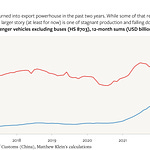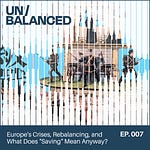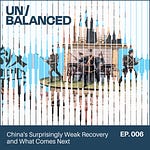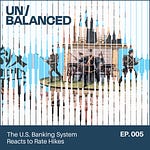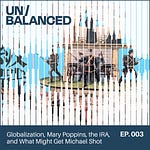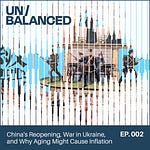Welcome back!
Many of you know of Michael through his work on China, but before he moved to Beijing, he was in New York trading and underwriting Latin American debt. The Volatility Machine—a great book that for reasons I do not understand is now extremely expensive—was informed by those experiences. So it was great to talk with Michael about Argentina’s ongoing financial crisis and new president Javier Milei’s goal of eventually replacing the Argentine peso with the U.S. dollar.
We covered a lot of ground, including the similarities between pre-Peron Argentina and the antebellum American south, development experts’ changing views of Latin America vs. East Asia, why Pettis thinks that Peronist import substitution gets a bad rap, and the political economy of debt forgiveness.
Hope you enjoy! Full edited transcript below the fold.
Remember, subscribers cover our cost of production. Paying listeners get to listen to the full recording and read the full transcript.
Related links:
Argentina and the Limits of Fiscal Space — The Overshoot
The Economic Development of Latin America and its Principal Problems — ECLA (Raúl Prebisch)
The Terms of Trade and the Rise of Argentina in the Long Nineteenth Century — Joseph Francis
Matt Klein: Hello! And welcome back to UN/BALANCED, a listener-supported podcast about the global economy and financial system. I’m Matt Klein.
Michael Pettis: And I’m Michael Pettis. Today we’re going to take a look at a country that’s been in the news quite a lot very recently because of their recent elections, which is, of course, Argentina.
It’s reputed to be one of the few countries to have steadily declined from being one of the richest in the world per capita to, at best, a middle-income country. It has been in an ongoing financial crisis for the past five years. Some more skeptical people might argue it’s been in an ongoing financial crisis for the past 50 years. It just elected a new president, Javier Milei, who wants Argentina to eliminate its central bank, eliminate a whole series of ministries, and abandon the peso for the U.S. dollar.
Matt Klein: And I think this will be a fun topic for us because, even though you’ve been in China for over 20 years at this point—and have developed a major reputation for that—you cut your teeth on the Latin American debt crises. And being widely read and financially economic history, this is a topic that you’ve spent a lot of time thinking about over the years, as well as something we discussed in our book insofar as it related to the history of financial crises and financial globalization. So I think this should be a really interesting conversation.
Michael Pettis: I think, Matt, you’re not allowed to have a conversation on the Argentine economy without making reference to a quote by, I forget who, who basically said there are three types of economies in the world: there are advanced economies, there are developing economies, and then there’s Argentina. And I think that gets at how strange the economic history of Argentina has been.
Matt Klein: You know, I’ve heard another version of that joke where there’s a fourth one, which is Japan, but we could maybe save that for another time.
Michael Pettis: Well, yeah, that was a joke in the 1980s. We don’t believe that anymore.
Matt Klein: Right. So let’s get started with what for me is kind of the basic question, which is: if we zoom out and look at Argentina from the late 1800s, it looks a lot like Australia and Canada. It is a New World society populated overwhelmingly by European immigrants; the wealth of the country is almost entirely in commodities; the land is very conducive for extracting agricultural or industrial products and then exporting them; and there were strong ties to the British Empire.
And yet, if we look at the trajectory of those three countries, Australia and Canada more or less end up kind of developing in similar ways—obviously, there are important differences—but Argentina goes in a completely different direction, starting around sort of the 1930s/1940s. What is the argument for why that happened? Maybe you can kind of lay out what you think has happened.
Michael Pettis: Well, you know, in my early career days… As you know, I was involved in trading and capital markets, specializing particularly in Latin America. I did, I think, the second bond issue by the Argentine government after it had finally returned to the markets after the debt crisis of the 1980s. And it’s sort of a joke that if you put two Argentines in a room and ask them what happened, not only will you get completely different answers from each of them, but one of them will end up having to kill the other one. It’s a really hotly debated topic.
There are people who argue that things went seriously wrong in the 1930s. Others argue that things began to go wrong after World War II, under Perón. And still others will argue everything was fine until the 1970s, and then things went seriously wrong there. It’s hard to say.
I think one of the important issues that we sometimes forget is that although there is a consensus that Argentina, on a per capita basis, was one of the richest countries in the world at the beginning of the 20th century, that wealth was very unevenly distributed and was almost wholly accounted for by the incredible productivity of Argentine agriculture.
It didn’t really show up in the cities and it didn’t really show up in the industrial side. Argentina was a very typical poor country, by that standard.
It was the very wealthy landowners that brought up Argentine per capita income to advanced country levels. The stereotype of Argentina in the 1910s and the 1920s was the romantic Argentine polo-playing-millionaire. They were all supposed to be millionaires, and I suspect it’s probably because either they were, or they were extremely poor.
Matt Klein: Right. There’s an interesting thing I found recently: the economic historian Joseph Francis was looking into this, and he made the point that if you look at development indicators other than GDP per capita, Argentina does not look like a rich country by the standards of the late 1800s or early 1900s, whether it’s education, or health, or things like that. Instead, it looks a lot more like a poor country.
From that perspective, what we see from the 1930s onwards looks a lot more like convergence to those indicators rather than some kind of surprising decline. I don’t know if that’s really the right way of thinking about it, but it’s an interesting perspective.
Michael Pettis: Well, it’s sort of consistent with what I’ve heard, which is that really Argentina was not a rich country. Certain Argentines were fabulously wealthy because of the incredible productivity of the agricultural sector. And so they brought the averages up, but median incomes were probably way below the average income.
Matt Klein: So then one question would be: even given that, what changed in the past—depending on your time horizon, 50 years or 80 years or 90 years—to lead to the divergence in reported GDP per capita between Argentina and Australia, Canada, or even the United States?
Michael Pettis: With such high levels of income inequality, what ends up happening is that Argentine wealth gets exported into England or the U.S. or places where it’s safe, and you don’t really develop strong enough domestic demand to boost the domestic services industry, domestic manufacturing, et cetera, et cetera. That could be one of the explanations. I’m not really sure. And as I said, it’s such a hotly debated topic that almost anything you say—if there is any Argentine listening to us, he or she will almost certainly disagree. It’s just a very hotly debated topic.
Matt Klein: Right. One other comparison—and maybe this is too speculative—is to think of New Zealand. This is also a country that has gotten quite wealthy from agricultural wealth. It doesn’t really have a manufacturing sector. There are other parts of the economy, and they’re not unproductive, but nevertheless, it seems that a lot of their wealth comes from this agricultural productivity, particularly for having a lot of grass for raising lamb and so forth.
Is it just the institutional quality and the distribution of that wealth that leads to such different outcomes? Are there other things that we can think about or point to? In your conversations with Argentines, what are the sort of things that they might say?
Michael Pettis: One of the points that we make in our book is that it’s not just productivity that matters; it’s the distribution of the benefits of that productivity. Perhaps the argument is that Argentina was very productive, but that productivity wasn’t well distributed, unlike, say, in New Zealand, where it’s much more evenly distributed, and so you’re capable of building up a modern economy.
But you know, one of the things that I’ve heard repeatedly is that there is an institutional problem within Argentina. It’s the central government that is primarily responsible for raising revenues by borrowing and raising taxes, and it’s the local governments, the state governments, or provincial governments that do most of the spending.
One of the arguments that I heard there is that you have this continuous gap between the spending of the provinces and the capital raising of the central government. One consequence is that it constantly has to be balanced by domestic borrowing. More importantly, it results in aggregate demand exceeding the productive capacity of the Argentine economy, and as a result, you end up having these periodic bouts of inflation in an attempt to adjust the two.
Now, I don’t know if that’s changed. That used to be a very common argument back when I was trading Argentina. The convertibility law, which was in, I think, in 1991, was a kind of dollarization, in part to make it impossible for that to happen. You could not spend more than you raised in revenue because you had to borrow, effectively, in dollars. The borrowing was in pesos, but the convertibility law created a currency board in which every peso was, in theory—turns out, not in practice—backed by a dollar.
Before that, Argentina had a currency called the austral, which was created in 1985 as a way of dealing with the hyperinflation of the peso. So they went from the peso to the austral, but the austral was even more hyperinflationary, so they went back to the peso under the convertibility law, through a currency board.
For those who don’t know what a currency board is, a currency board replaces a central bank. And what happens is that the currency board issues currencies only to the extent that they are 100 percent backed by something else, in this case, U.S. dollars. So for every dollar that entered into the currency board, they would then create one peso.
The disciplinary impact is a little bit like a really hard gold system. The disciplinary impact is that if you keep borrowing dollars, people become nervous about your ability to repay the dollar, and so you get cut off from the financial markets. And that was supposed to be the straitjacket that forced provincial governments to operate within the budget of tax collection of the central government.
Of course, that didn’t really work. The currency board broke, I think it was in 2001. We can talk about why that happened, I was very involved in that on the trading side. But, in a sense, dollarization, which is probably not going to happen very quickly, if it happens, would be an attempt to repeat the convertibility of 1991 and force a budget constraint onto the Argentine government.
Matt Klein: You know, this gets into a good segue to the next general question I have about all this, which is: you’re looking at our book, or looking at some of the events that you just described, Argentina has been a very frequent participant in financial crises, whether it’s global phenomena or sort of idiosyncratic ones. I think it’s one of the most frequently defaulting sovereigns in modern history. Why is that?
Michael Pettis: There are different reasons for different crises. The first really famous crisis, the first global one, was in 1890. That resembles the Mexican crisis of 1994-1995, in the sense that Argentina had a gold backed currency, like many other countries, but it was an economy that had great difficulty in maintaining the gold backing of the currency. They borrowed a huge amount in the London markets for municipal improvements, most famously the municipal water system, which was underwritten by—I think they were the oldest English bank at the time—Baring Brothers. And very famously, they got into trouble.
They tried to resolve the problem by breaking the link between the currency and gold, and unfortunately when that happens you get a depreciation in your currency, but you don’t get a depreciation in your debt, which was still gold linked, so you end up with that explosive growth in what is supposed to be domestic debt, but is domestic debt linked to an external currency, sterling and gold in this case, and the debt gets out of hand and you default.
It was a massive default. It brought down Baring Brothers. The only reason they didn’t go bankrupt is because the Bank of England basically corralled a whole bunch of banks together, including Baring’s great enemy, the Rothschilds, and forced them to bail Baring’s out.
Weirdly enough, in the 1930s, when everybody in Latin America defaulted, the one exception was Argentina. And that really strengthened their reputation, which allowed them to be among the biggest borrowers in the 1960s and 1970s. But, of course, that ended with the debt crisis of 1982, and ever since then, they’ve been a regular defaulter. The argument has always been this gap between provincial borrowing and central government tax collection.
Listen to this episode with a 7-day free trial
Subscribe to UN/BALANCED to listen to this post and get 7 days of free access to the full post archives.





